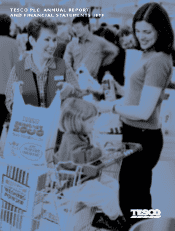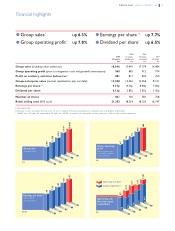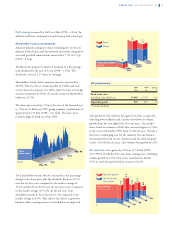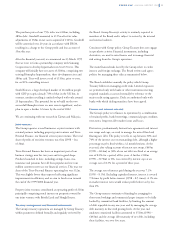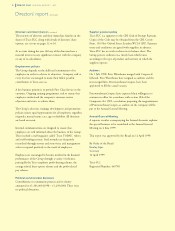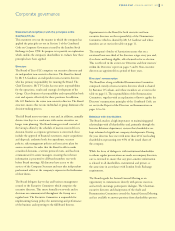Tesco 1999 Annual Report Download - page 7
Download and view the complete annual report
Please find page 7 of the 1999 Tesco annual report below. You can navigate through the pages in the report by either clicking on the pages listed below, or by using the keyword search tool below to find specific information within the annual report.
TESCO PLC ANNUAL REPORT 1999 5
The purchase price of our 75% stake was £206m, including
£89m debt. Goodwill amounted to £117m after fair value
adjustments of £38m on net assets acquired of £127m. Goodwill
will be amortised over 20 years in accordance with FRS10,
resulting in a charge to the Group profit and loss account of
£5m this year.
After the financial year end, we announced on 23 March 1999
that we were to form a partnership company with Samsung
Corporation to develop hypermarkets in South Korea. This
company will initially have net assets of £160m, comprising two
existing Homeplus hypermarkets, three development sites and
£80m cash. Tesco will invest a total of £130m, prior to costs,
for an 81% controlling interest.
South Korea is a large developed market of 46 million people
with GDP per capita already 70% of that in the UK but, in
contrast, modern retailing is underdeveloped with only around
25 hypermarkets. The potential for us to build on the two
successful Homeplus stores we now own is significant, and we
plan to open a further 12 stores by the end of 2002.
We are continuing with our research in Taiwan and Malaysia.
Joint ventures
The Group operates several businesses as joint ventures with
external partners including property joint ventures and Tesco
Personal Finance, our financial services joint venture. The total
share of profits of our joint ventures was £6m (1998 – loss
of £6m).
Tesco Personal Finance has been an important part of our
business strategy now for two years and is in good shape.
Products launched to date, including savings, loans, visa,
insurance and pensions have all been popular and over one
million customers now use our financial services. This year our
share of the Tesco Personal Finance operating loss was £12m.
This was slightly better than expected reflecting significant
improvements in efficiency and we aim to break even towards
the end of the 1999/2000 financial year.
Property joint ventures contributed an operating profit of £18m
principally comprising rental income on properties owned by
our joint ventures with British Land and Slough Estates.
Treasury management and financial instruments
The Group’s treasury operations are managed by Group Treasury
within parameters defined formally and regularly reviewed by
the Board. Group Treasury’s activity is routinely reported to
members of the Board and is subject to review by the internal
and external auditors.
Consistent with Group policy, Group Treasury does not engage
in speculative activity. Financial instruments, including
derivatives, are used to raise finance and to manage financial
risk arising from the Group’s operations.
The main financial risks faced by the Group relate to credit,
interest and foreign exchange. The Board reviews and agrees
policies for managing these risks as summarised below.
The Board establishes annually the policy which Group
Treasury follows in managing credit risks. Limited exposures
are permitted only with banks or other institutions meeting
required standards as assessed normally by reference to the
major credit rating agencies. Deals are authorised only with
banks with which dealing mandates have been agreed.
Finance and interest rate risk
The Group’s policy is to finance its operations by a combination
of retained profits, bank borrowings, commercial paper, medium
term notes, long term debt market issues and leases.
Derivatives, predominantly forward rate agreements and interest
rate swaps and caps, are used to manage the mix of fixed and
floating rate debt. The policy is to fix or cap between 30% and
70% of the interest cost on outstanding debt, although a higher
percentage may be fixed within a 12 month horizon. At the
year end, after taking account of interest rate swaps, £649m
(1998 – £614m) or 38% of our net debt was fixed at an average
rate of 8.2% for a period of five years. A further £100m
(1998 – £170m) or 6%, was covered by interest caps at an
average rate of 8.3% for a period of three years.
The average rate of interest paid during the year was 7.1%
(1998 – 8.1%). Excluding capitalised interest, interest is covered
7.8 times by profit before interest (1998 – 8.5 times). A 1% rise
in market interest rates would reduce profit before tax by less
than 2%.
The Group ensures continuity of funding by arranging for
short term bookings and commercial paper issuance to be fully
backed by committed bank facilities, by limiting the amount
of debt repayable in any one year, and by managing the average
debt maturity in line with gearing levels. At the year end
undrawn committed facilities amounted to £510m (1998 –
£645m) and the average debt maturity of net debt, including
these facilities, was over five years.

